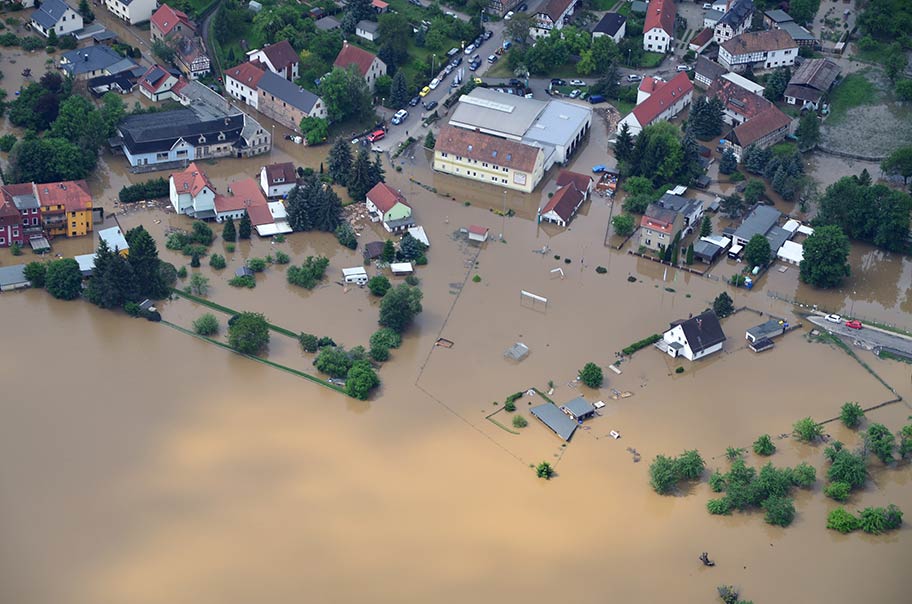
Deep South, deep risk: Region faces climate adaptation challenges
In the news
President Barack Obama is to visit flood-ravaged Louisiana today in the wake of inundating high water that killed 13 people and left more than 100,000 seeking federal assistance. The Great Flood of 2016 is being called the worst U.S. natural disaster since Hurricane Sandy in 2012, with 4,000 people in shelters days after rains subsided and 40,000 homes damaged or destroyed.
Back story
Flooding from extreme rains is just one of many serious climate risks facing the Southeast. Predictions call for coastal flooding and erosion related to sea-level rise and hurricanes, not to mention worsening heat waves and drought. One major analysis says the Southeast and Texas are two of the hottest and most weather vulnerable areas in the country, and warns of significant climate change impacts on heat-related mortality, agriculture, energy demand and economic productivity.
Risks vary throughout the region. For instance, according to Climate Central, Florida has the largest population in the country vulnerable to inland flooding, with 1.5 million residents living in the inland FEMA floodplain. Georgia is third most at risk, after California, with 570,000 people. And both Florida and Louisiana face far greater coastal flooding threats than other coastal states. But it’s not just about floods. Heat waves are a particular problem in the Southeast and Gulf Coast, while wildfires threaten Florida, North Carolina and Georgia, as well as Arkansas, Alabama, Louisiana and Mississippi.
Adaptation angle
Stories for the region go beyond immediate or even long-term climate risk. They can include reporting on near-term preparations for climate disruption, such as improved flood barriers or drainage to prevent injury and damage from floods. It can also mean reporting on preparedness for emergency evacuation and temporary mass housing, or plans for cleanup and getting an area back on its feet after an extreme event. But it should also mean reporting on what a community is planning in the way of more resilient infrastructure to avoid disruptions in the first place — disruptions to transportation, energy, property, water, food and business supply chains.
Questions to ask
- What are the specific risks to your community with changing climate, and to what extent is local or state government recognizing and responding to them near-term and long term?
- What kinds of emergency response plans are in place for extreme weather in your area, like hurricanes, extreme rains or heat waves? Are there evacuation routes and do residents know about them?
- How could drought affect water supplies in your area, whether for drinking, agriculture, business or recreation? What plans are in place to respond?
- How could heat waves affect public health, businesses or infrastructure in your area? Does your community suffer from urban heat island affect? What are the plans to respond?
- How could flooding affect your area, in terms of risk to life, loss of housing, or disruption of transportation or energy supplies? How are mold and leftover debris handled? How might flooding from rains and rising seas interact? What can be done to protect the community?
- What are the possible disruptions to local infrastructure from the various risks your area is facing? How are authorities responding?
- What are home values in threatened communities? For instance, flood-affected areas in Louisiana this past week included 110,000 homes worth a combined $20.7 billion and more than 7,000 businesses.
- We offer more questions to ask on these risks and possible responses in our library of climate adaptation news backgrounders. For more, see backgrounders on drought, inland flooding, wildfires, heat waves, health and heat, adaptation in cities and public funding of adaptation.
Reporting resources
Dig deeper on adaptation in the South using the dozens of related resources in the database of the Reporter’s Guide to Climate Adaptation.
- For a regional examination of climate risk, see the most recent U.S. National Climate Assessment. It has a detailed section on the Southeast focusing on the risks of sea-level rise, extreme heat and decreased water availability, as well as an interactive adaptation response map with a handful of initiatives in the South and around the country.
- Another regional analysis comes from the Risky Business Project, which has an extensive special report on the Southeast United States that details a wide range of economic risks from climate change, as well as risks to manufacturing. The report also includes a state-by-state analysis of risk for 11 Southeastern states and Texas.
- For regional agricultural climate challenges, explore the U.S. Department of Agriculture’s regional climate hubs for a discussion of the Southeast region’s climate vulnerability and responses.
- More on state-by-state preparedness can be gleaned through Climate Central’s States at Risk Report Card, which provides an interactive map interface for users to examine each Southern state’s adaptation planning for risks like extreme heat, drought, wildfires and flooding.
- Explore cities in the Southeast that are focused on resilience using the 100 Resilient Cities site. The Rockefeller Foundation initiative includes large urban centers such as Atlanta, Miami and New Orleans, as well as smaller cities like El Paso, Texas; Louisville, Kentucky; Nashville, Tennessee; and Norfolk, Virginia.
- National parks in the Southeast are at risk as well. Reporters can navigate an interactive map with parks dotted along the region for details of specific level of risk. Another report looks at the challenges faced by U.S. national landmarks in the Southeast and beyond.
- Research state- and regional-level initiatives and data, such as North Carolina’s sea-level rise challenge, the Southeast Florida’s regional climate change compact, the Texas Coastal Communities Planning Atlas, New Orleans Index at Ten resiliency analysis, or the American Sustainable Business Council’s Businesses Acting on Rising Seas project in South Carolina.
Plus, see our recent news backgrounder on inland flooding and adaptation.
Know of other Southeastern-related adaptation resources we should have in our database?
- Share your resources.
- Share your Southeastern adaptation stories and story angles.

Comments